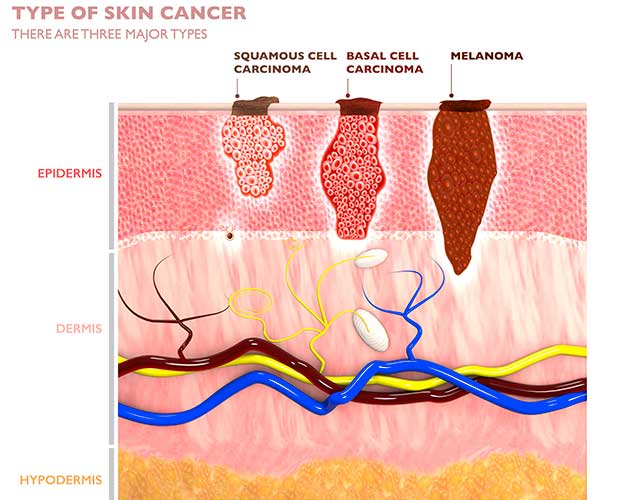Squamous Cell Carcinoma Overview

What is squamous cell carcinoma?
Squamous cell carcinoma is a very common form of skin cancer that develops in the squamous cells—the flat, thin cells found in the top layers of the skin as well as parts of the lungs, urinary tract and mucous membranes. According to the Skin Cancer Foundation, 1.8 million cases of squamous cell carcinoma are diagnosed every year, and the incidence of this disease has skyrocketed 200% in the past three decades.
Invasive squamous cell carcinoma
Squamous cell carcinoma is highly treatable when it is identified in an early stage; however, if left unaddressed, the cancerous lesion can become invasive, meaning it could spread to and develop in surrounding tissues, can cause disfigurement and may become deadly. More than 15,000 Americans die from squamous cell carcinoma every year. That's why it's vital to detect and treat squamous cell carcinoma early. There's a better chance of detecting squamous cell carcinoma early when you know how to identify the signs and symptoms of the condition.
Signs of squamous cell carcinoma
Squamous cell carcinomas usually look like an abnormal wart, rash or wound on the skin that does not heal. Specifically, this cancer can appear as:
- A round, firm growth that may crust or bleed
- An open sore that may crust or bleed
- A red, scaly patch that may crust or bleed
- An elevated growth with a depression that may crust, bleed or expand rapidly
Most squamous cell carcinomas develop on parts of the skin that are regularly exposed to the sun, such as the neck, hands, arms, lips, ears and face. However, some squamous cell carcinomas develop on the bottoms of the feet, genitals or the inside of the mouth. It’s also possible for cancers to grow on top of existing scars or ulcers.
The symptoms of squamous cell carcinoma and other skin cancers can vary from person to person, so it’s important to consult with a dermatologist or primary care physician about any new or unusual changes in skin.

Squamous cell carcinoma causes and risk factors
Squamous cell carcinoma occurs as a result of unusual changes (mutations) in the DNA of squamous cells. These changes instruct cells to continue living instead of dying at the end of their normal lifespan, causing abnormal cells to accumulate and form cancer. The most common cause of squamous cell mutations is ultraviolet (UV) radiation from excess sun exposure and tanning beds, but not all skin cancers can be attributed to UV rays. Sometimes, the cause of squamous cell carcinoma is unclear.
While there is still more to learn about squamous cell carcinoma, researchers have identified several risk factors besides UV exposure that can leave an individual more likely to develop this skin cancer. These include:
- Fair skin
- A family history of skin cancer
- A weakened immune system
- Advanced age (most squamous cell carcinomas develop after age 50)
- Human papillomavirus (HPV) infection
- Skin inflammation or chronic infections from scars or burns
It’s impossible to definitively prevent any type of cancer, but there are ways to reduce the risk of squamous cell carcinoma. Simple ways to help minimize skin cancer risk include:
- Wearing sunscreen that has an SPF of at least 30, even on cloudy days
- Avoiding tanning beds
- Getting regular skin checkups with a dermatologist
- Wearing protective clothing while outside, including broad-brimmed hats and sunglasses
- Planning outdoor activities when the sun isn’t as intense, like the early morning or evening hours
It’s also important to examine your skin at least once a month for new or abnormal growths and to see a dermatologist annually for a more comprehensive check.
Treatment options for squamous cell carcinoma
While squamous cell carcinoma can spread to other parts of the body and become deadly, it is usually very responsive to treatment. When detected and treated early, squamous cell carcinomas (together with basal cell carcinomas, the other type of nonmelanoma skin cancer) have a survival rate of more than 95%.
A person’s squamous cell carcinoma treatment plan will depend on several factors, including the stage and location of the cancer as well as the patient’s age and overall health.
Smaller cancers can often be destroyed through noninvasive or minimally invasive procedures such as:
- Cryotherapy
- Curettage and electrodessication (also called C and E treatment)
- Mohs surgery, which involves removing cancer layer by layer
- Radiation therapy
Moffitt Cancer Center’s approach to squamous cell carcinoma
At Moffitt Cancer Center, we take a comprehensive, multispecialty approach to diagnosing and treating squamous cell carcinoma. Our Cutaneous Oncology Program makes it possible for patients to consult with a number of specialists in a single location. Our team consists of:
- Dermatologists
- Surgical oncologists
- Plastic surgeons
- Radiation oncologists
- Dermatopathologists
- Radiologists
- Supportive care providers
- Medical oncologists
Because these providers work exclusively toward the diagnosis and treatment of skin cancer, they have extensive experience and can provide each patient with an effective, individualized treatment plan. At Moffitt, we offer a complete range of treatments for squamous cell carcinoma, from Mohs micrographic surgery (offered in conjunction with the USF Department of Dermatology) to targeted radiation therapy. Cryotherapy and dermabrasion are also options available to our patients. We individualize each patient’s treatment plan to reflect his or her specific diagnosis and personal preferences, while taking care to consider aesthetic outcomes and important factors related to quality of life.
Moffitt is changing the healthcare model and improving access to world-class cancer treatment. To learn more about our approach to squamous cell carcinoma and rapidly connect with a cancer specialist, call 1-888-663-3488 or submit a new patient registration form online.
Helpful Links:
